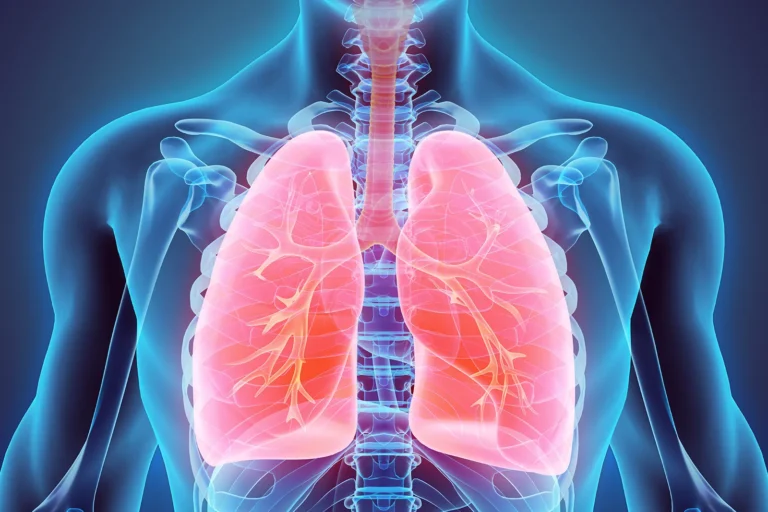Lung Cancer

Lung Cancer
Lung cancer is a malignant tumor originating in the lungs, typically in the cells lining the air passages. It is one of the most prevalent and deadly forms of cancer worldwide. The disease is often associated with long-term exposure to tobacco smoke. Still, it can also affect non-smokers due to various risk factors such as environmental pollutants and genetic predisposition.
Lung cancer can be categorized into two main types: non-small cell lung cancer (NSCLC) and small cell lung cancer (SCLC), each with distinct characteristics and treatment approaches. Symptoms may include persistent cough, shortness of breath, chest pain, and unexplained weight loss. Early detection through screening and improved treatment options have increased survival rates, but lung cancer remains a significant health concern, emphasizing the importance of prevention and awareness.
Causes
Lung cancer is primarily caused by the uncontrolled growth of abnormal cells in the lungs. These cells can form tumors and interfere with the normal functioning of the lungs.
There are several risk factors and causes associated with the development of lung cancer:
- Smoking: Smoking tobacco is the leading cause of lung cancer. It is responsible for most lung cancer cases. This includes not only cigarette smoking but also cigar and pipe smoking. The harmful chemicals in tobacco smoke, such as carcinogens, damage the lung tissue and DNA, leading to the development of cancerous cells.
- Secondhand Smoke: Exposure to secondhand smoke, also known as passive smoking, can increase the risk of lung cancer in non-smokers. Breathing in the smoke from others who are smoking can be harmful.
- Radon Gas: Radon is a naturally occurring radioactive gas that can seep into homes and buildings. Prolonged exposure to high levels of radon can increase the risk of lung cancer.
- Occupational Exposures: Some people are exposed to carcinogens in their workplace, such as asbestos, arsenic, and certain chemicals, which can increase their risk of developing lung cancer.
- Air Pollution: Long-term exposure to high levels of air pollution, especially in urban areas, may increase lung cancer risk.
- Genetic Factors: While most cases of lung cancer are related to environmental factors, a small percentage of cases may have a genetic component, where a family history of lung cancer can increase the risk.
- Previous Lung Diseases: People with a history of certain lung diseases, such as chronic obstructive pulmonary disease (COPD), are at an increased risk of developing lung cancer.
It’s essential to note that not everyone exposed to these risk factors will develop lung cancer, and not all cases of lung cancer can be linked to a specific cause. Early detection, lifestyle changes, and avoiding known risk factors like smoking are essential steps in reducing the risk of lung cancer. If you have concerns about your risk or symptoms related to lung cancer, it’s advisable to consult with a healthcare professional for further evaluation and guidance.
Symptoms
Lung cancer can cause a variety of symptoms. Still, it’s important to note that not everyone with lung cancer will experience the same symptoms, and some people may not have any symptoms at all, especially in the early stages.
Common symptoms of lung cancer can include:
- Persistent cough: A cough that doesn’t disappear or worsens over time is a common symptom. It may produce mucus or blood.
- Shortness of breath: Breathlessness or wheezing can be a sign of lung cancer, especially if it persists or worsens.
- Chest pain: Dull, aching, or sharp chest pain may be felt, and it can worsen with deep breathing, coughing, or laughing.
- Coughing up blood: Coughing up blood, or hemoptysis, is a concerning symptom and should be evaluated by a healthcare professional.
- Hoarseness: A persistent change in voice, such as hoarseness, can be an early sign of lung cancer.
- Unexplained weight loss: Sudden and unexplained weight loss, especially if it’s significant, can be a symptom of various cancers, including lung cancer.
- Fatigue: Severe fatigue and weakness that doesn’t improve with rest can be a symptom of advanced lung cancer.
- Loss of appetite: A decrease in appetite that leads to unintended weight loss can be associated with lung cancer.
- Recurrent respiratory infections: Frequent infections such as bronchitis or pneumonia may indicate an underlying lung issue, including lung cancer.
- Bone pain: If the cancer has spread to the bones, it can cause bone pain, often in the spine, ribs, or hips.
- Headaches: Lung cancer that has spread to the brain may cause headaches, seizures, or other neurological symptoms.
- Swelling in the face or neck: Blockage of the blood vessels in the chest can lead to swelling in the face, neck, and upper chest.
It’s important to keep in mind that many of these symptoms can be caused by conditions other than lung cancer. However, if you or someone you know is experiencing persistent or unusual symptoms, it’s essential to consult a healthcare professional for a proper evaluation and diagnosis. Early detection of lung cancer can improve treatment outcomes, so don’t ignore any concerning symptoms.
Diagnosis
Diagnosing lung cancer typically involves a combination of medical history assessment, physical examination, and various diagnostic tests.
Here are the critical steps in the diagnostic process for lung cancer:
- Medical History and Physical Examination: The doctor will begin by taking a detailed medical history, which includes asking about your risk factors, such as smoking history, exposure to asbestos or other carcinogens, and any family history of lung cancer. A physical examination may be performed to check for any signs or symptoms related to lung cancer, such as abnormal lung sounds or enlarged lymph nodes.
- Imaging Tests: Chest X-ray is often the initial imaging test to identify lung abnormalities. However, it may not be sufficient to confirm the presence of lung cancer or provide detailed information about it.
- CT Scan (Computed Tomography): A CT scan of the chest provides more detailed images of the lung tissue and can help identify the size, location, and characteristics of lung nodules or masses. It’s a standard tool for lung cancer diagnosis.
- Biopsy: If suspicious abnormalities are found on imaging, a biopsy is typically necessary to confirm the presence of lung cancer and determine its type. There are several types of biopsies:
- Fine Needle Aspiration (FNA): A thin, hollow needle extracts a small tissue sample from the suspicious area.
- Core Needle Biopsy: A more extensive, hollow needle collects a larger tissue sample.
- Bronchoscopy: A flexible tube with a camera is inserted through the mouth or nose into the airways to obtain tissue samples.
- Surgical Biopsy: In some cases, a surgical procedure may be required to remove a piece of lung tissue for examination. This is often done when other biopsy methods are inconclusive.
- Pathology and Laboratory Tests: Once a tissue sample is obtained, it is sent to a laboratory for pathological examination. Pathologists will analyze the tissue to determine if it is cancerous, what type of lung cancer it is (e.g., non-small cell lung cancer or small cell lung cancer), and its grade (how aggressive it is).
- Staging and Additional Tests: If lung cancer is confirmed, further tests may be performed to determine the stage of the cancer. Staging helps determine the extent of the cancer and guides treatment decisions. These tests may include additional imaging (e.g., PET scan), blood tests, and sometimes genetic testing to guide personalized treatment options.
- Pulmonary Function Tests (PFTs): These tests assess how well the lungs function and can help determine if the patient is a candidate for surgery or other treatments.
- Consultation with Specialists: A team of healthcare professionals, including pulmonologists, medical oncologists, radiation oncologists, and surgeons, will collaborate to develop a comprehensive treatment plan based on the diagnosis and staging of lung cancer.
The diagnostic process may vary based on individual circumstances and the healthcare facility’s protocols. It’s essential to consult with a healthcare provider to discuss your specific situation and develop an appropriate diagnostic plan if you have concerns about lung cancer.
Treatment
The treatment of lung cancer depends on the type and stage of the cancer, as well as the overall health of the patient. Several treatment options are available, and a combination of treatments is often used. Here are some of the primary treatment modalities for lung cancer:
- Surgery: Surgical removal of the tumor is a standard treatment for early-stage lung cancer. The extent of surgery may vary, from a wedge resection (removing a small part of the lung) to a lobectomy (removing an entire lobe of the lung) or pneumonectomy (removing an entire lung).
- Radiation therapy: This involves using high-energy X-rays or other forms of radiation to kill or shrink cancer cells. Radiation therapy can be used as the primary treatment for some lung cancers, especially when surgery is not an option or in combination with surgery and chemotherapy.
- Chemotherapy: Chemotherapy uses drugs to kill cancer cells or stop their growth. It is often used for more advanced or metastatic lung cancers or as an adjuvant therapy following surgery to reduce the risk of cancer recurrence.
- Targeted therapy: Targeted therapies are drugs specifically targeting specific genetic mutations or proteins involved in the growth and spread of cancer cells. They are primarily used for non-small cell lung cancer (NSCLC) with specific mutations, such as EGFR, ALK, ROS1, or BRAF.
- Immunotherapy: Immunotherapy drugs help the body’s immune system recognize and attack cancer cells. Checkpoint inhibitors like pembrolizumab and nivolumab are often used for advanced-stage lung cancer, particularly in cases where other treatments have not been successful.
- Palliative care: Palliative care focuses on improving the quality of life for patients with advanced lung cancer. It provides relief from symptoms, pain management, and emotional support to help patients and their families cope with the disease.
- Clinical trials: Participation in clinical trials may be an option for some patients, especially those with advanced or hard-to-treat lung cancer. Clinical trials test new therapies and treatment approaches to evaluate their safety and effectiveness.
The choice of treatment depends on factors such as the type and stage of lung cancer, the patient’s overall health, and the presence of specific genetic mutations or biomarkers. Patients must work closely with their healthcare team to develop a personalized treatment plan best suits their situation. Additionally, early detection and prevention through smoking cessation and regular screening for individuals at high risk can improve the chances of successful treatment and better outcomes.


